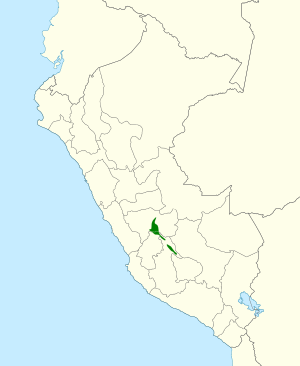Black-spectacled brushfinch facts for kids
The black-spectacled brushfinch (Atlapetes melanopsis) is a small bird. It belongs to the Passerellidae family, which includes sparrows and buntings. This special bird lives only in Peru, making it an endemic species. It was first described in 1999.
Quick facts for kids Black-spectacled brushfinch |
|
|---|---|
| Conservation status | |
| Scientific classification | |
 |
|
| Synonyms | |
|
Atlapetes melanops Valqui & Fjeldså, 1999 |
Contents
What is a Black-spectacled Brushfinch?
The black-spectacled brushfinch is a type of bird known for its unique markings. It has dark "spectacles" around its eyes, which is how it got its name. These birds are usually found in specific parts of Peru. They are part of a larger group of birds called brushfinches.
Where Does This Bird Live?
This brushfinch lives in particular places in Peru. Its natural habitats are high up in the mountains. You can find it in two main types of areas:
- Subtropical or tropical moist montane forests: These are forests that get a lot of rain and are found on the slopes of mountains in warm regions.
- Subtropical or tropical high-altitude shrublands: These are areas with many bushes and shrubs, also found high up in the mountains where it can be quite cool.
These birds need these specific environments to find food and build their nests.
Why is This Bird Special?
The black-spectacled brushfinch is special because it is endemic to Peru. This means it lives naturally nowhere else in the world. It is a unique part of Peru's wildlife. Scientists are still learning about its habits and how it lives in these mountain areas.
What Threats Does It Face?
Sadly, the black-spectacled brushfinch is facing challenges. It is considered a "Near Threatened" species by conservation groups. This means it could become endangered if its situation does not improve.
Habitat Loss
The biggest threat to this bird is habitat loss. This happens when the places where the birds live are destroyed or changed.
- Deforestation: Forests are cut down for farming, logging, or building. This removes the trees and plants the birds need for shelter and food.
- Development: As human populations grow, more land is used for homes, roads, and other structures. This can break up the birds' natural areas.
When their habitat shrinks, it becomes harder for these birds to survive. They have less space to find food, raise their young, and stay safe. Protecting their mountain homes is very important for their future.
See also
 In Spanish: Atlapetes de anteojos para niños
In Spanish: Atlapetes de anteojos para niños


